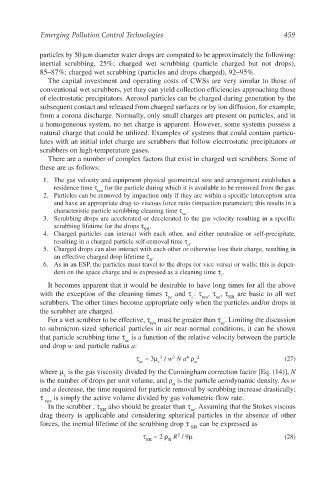Page 487 - Air Pollution Control Engineering
P. 487
12_ch_wang.qxd 05/05/2004 5:26 pm Page 459
Emerging Pollution Control Technologies 459
particles by 50 µm diameter water drops are computed to be approximately the following:
inertial scrubbing, 25%; charged wet scrubbing (particle charged but not drops),
85–87%; charged wet scrubbing (particles and drops charged), 92–95%.
The capital investment and operating costs of CWSs are very similar to those of
conventional wet scrubbers, yet they can yield collection efficiencies approaching those
of electrostatic precipitators. Aerosol particles can be charged during generation by the
subsequent contact and released from charged surfaces or by ion diffusion, for example,
from a corona discharge. Normally, only small charges are present on particles, and in
a homogeneous system, no net charge is apparent. However, some systems possess a
natural charge that could be utilized. Examples of systems that could contain particu-
lates with an initial inlet charge are scrubbers that follow electrostatic precipitators or
scrubbers on high-temperature gases.
There are a number of complex factors that exist in charged wet scrubbers. Some of
these are as follows:
1. The gas velocity and equipment physical geometrical size and arrangement establishes a
residence time τ for the particle during which it is available to be removed from the gas.
res
2. Particles can be removed by impaction only if they are within a specific interception area
and have an appropriate drag-to-viscous force ratio (impaction parameter); this results in a
characteristic particle scrubbing cleaning time τ .
sc
3. Scrubbing drops are accelerated or decelerated to the gas velocity resulting in a specific
scrubbing lifetime for the drops τ .
SR
4. Charged particles can interact with each other, and either neutralize or self-precipitate,
resulting in a charged particle self-removal time τ .
a
5. Charged drops can also interact with each other or otherwise lose their charge, resulting in
an effective charged drop lifetime τ .
R
6. As in an ESP, the particles must travel to the drops (or vice versa) or walls; this is depen-
dent on the space charge and is expressed as a cleaning time τ .
c
It becomes apparent that it would be desirable to have long times for all the above
with the exception of the cleaning times τ and τ . τ , τ , τ are basic to all wet
sc c res sc SR
scrubbers. The other times become appropriate only when the particles and/or drops in
the scrubber are charged.
For a wet scrubber to be effective, τ must be greater than τ . Limiting the discussion
res sc
to submicron-sized spherical particles in air near-normal conditions, it can be shown
that particle scrubbing time τ is a function of the relative velocity between the particle
sc
and drop w and particle radius a:
τ = 3µ / w Na ρ 2 (27)
3
4
3
sc c a
where µ is the gas viscosity divided by the Cunningham correction factor [Eq. (14)], N
c
is the number of drops per unit volume, and ρ is the particle aerodynamic density. As w
a
and a decrease, the time required for particle removal by scrubbing increase drastically;
τ is simply the active volume divided by gas volumetric flow rate.
res
In the scrubber , τ also should be greater than τ . Assuming that the Stokes viscous
SR sc
drag theory is applicable and considering spherical particles in the absence of other
forces, the inertial lifetime of the scrubbing drop τ can be expressed as
SR
τ = 2 ρ R / 9µ (28)
2
SR R

